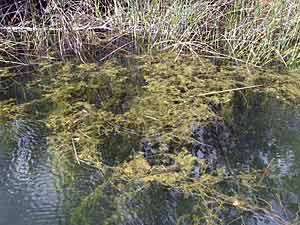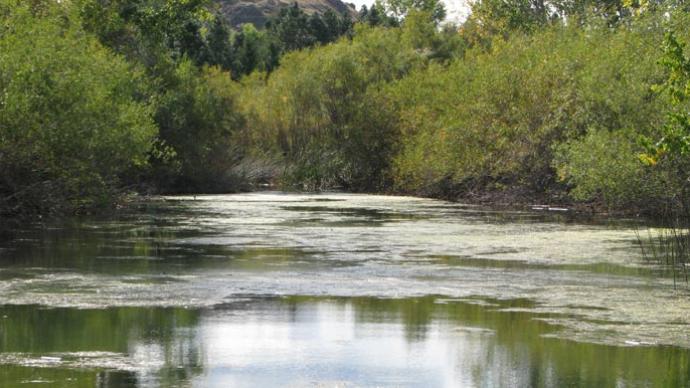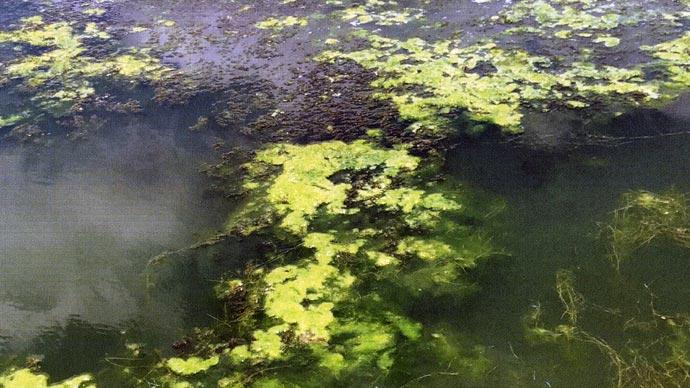
Spring is here, summer is looming and for those of us that manage lakes and ponds it's time for the annual battle with algae. Algae come in many forms, with tens of thousands of species being identified worldwide. Different forms of algae have been around for millions of years and have adapted to every aquatic environment imaginable.
You can even thank algae for providing much of the air we breathe through photosynthesis.
But, when you're faced with a bubbling, green mess of smelly mats in what formerly was your nice, clean body of water, the last thing you feel like saying is "thanks".
Whenever someone comes to me for advice on controlling algae, I first like to get an understanding of goals, resources and limitations. In my experience working with clients, one thing remains the same-nothing is the same! There are so many variables, such as: water source and quality, discharge volumes and options, irrigation requirements, shared resources, the fishery, livestock and the very purpose of your water, that to simply recommend a 'one size fits all' product for algae control is simply not wise.
It doesn't make sense to recommend chemical spraying to someone whose pond overflows like an out of control fire hose. Nor does it make sense to suggest aeration to a client with a lakeside wedding reception three days from today.
As a consultant, my role is to provide options and information and ask questions that you may not have even thought about to make the best decision based on individual circumstances.
So, what are some of the options available for algae control?
Nutrient Reduction
Algae, like most plants, require temperature, food and sunlight in order to grow. Reducing algae's food source is one method most lake owners have available to them in one way or another. The primary nutrient sources for algae are nitrogen and phosphorus, with phosphorus being the main ingredient for fresh water ponds. These nutrients are almost always available in man made lakes thanks to runoff from degraded or fertilized watersheds, decomposing organic matter, fish food, storm water inputs etc.
Management techniques for reducing nutrient inputs can be as grand as constructing an artificial wetland or as simple as manually netting or skimming out leaves from falling trees. If you don't have the luxury of an upstream bed to build a wetland, then floating islands or selected planting of non-invasive aquatic plants is another option.
Phosphate reduction can be achieved using various chemicals or minerals that are sprayed or dispersed over the water to bind up phosphates and drop them to the sediment layer. A commonly used product for this is aluminum sulphate. Careful, though. Alum, as it is commonly called, can rapidly change your water's pH, causing serious complications. In terms of guiding you how much alum is enough...it all depends on the chemistry of your water.
Nitrogenous nutrients can be controlled using bacteria in a process known as biological filtration. Use microbes to "eat" decaying matter, the same process going on in any kid's aquarium. In a pond, microbes combined with aeration expedites the process, but once algae begins it growth cycle, it can absorb nitrogen from the water. Since our atmospheric air has copious amounts of nitrogen, guess what happens? As algae pulls nitrogen from the water, more nitrogen is absorbed into the water from the air. It's a cycle.
Nutrient reduction isn't a quick fix for controlling algae but it's a good start and could well be a key method for long term management in conjunction with other tools from your algae control tool box.
Sunlight Reduction
Like nutrient reduction, limiting the amount of sunlight can also help with some types of algae control, especially filamentous species and some of the smaller types such as planktonic algae. Inert pond dyes are available that turn water various shades of blue and reduce the amount of sunlight available to plants and algae. Quite a few managers have learned to dye their ponds during late winter to prevent the first onslaught of algae as the water warms.
Another way of reducing sunlight is to selectively plant non-invasive plants in and around the pond, especially those with floating leaves, such as lilies. Such plants can reduce the amount of sunlight on the surface water as well as help with nutrient uptake.
The catch-22 here is to be sure you choose plants that like to grow in similar temperature water as the algae.
Straw Bales
Straw bales have been an old rancher's tale method of algae control for years. Some people swear that throwing a bale of straw into a pond will keep algae at bay. Like all good yarns, this is part truth and part myth.
As straw breaks down in water it creates a wonderful environment for micro and macro invertebrates, many of which feed on algae, so it's not the straw keeping the algae at bay but the millions of water bugs, tiny insects and microbes that eventually come with it. The downside to this method is you end up with a bunch of decomposing straw at the bottom of your pond that, in turn, becomes a nutrient source for future algal blooms.
Barley straw is commonly used in backyard water gardens but its success in lakes and ponds is sporadic. As barley straw steeps, similar to tea, it gives off an acid based extract that acts to inhibit the growth of certain types of algae. While the scientific community hasn't yet embraced the reasons behind the effectiveness of barley straw, a number of pond managers use it effectively. Lavender is thought to have similar effects.
Fish
It's not unusual for a client to seek white amur, commonly called "grass carp," as a treatment option for algae. Forget grass carp. They can't eat algae. But, consider tilapia. A word of caution here, too. Some states won't allow tilapia. Others allow the semi-tropical fish, but with a permit. Still, some states regulate which species can be brought into your private waters. Tilapia, stocked in at least 15- 20 pounds per surface acre each spring when the water is warm enough, has proven to be an effective algae control method.
Chemical Treatments
Several chemicals have been used for algae control but, in large bodies of water, many become economically unfeasible. Derivatives of copper are probably the most commonly used chemical today but the industry has mostly moved beyond the days of copper sulphate to safer chelated copper products registered for most applications.
Nowadays the use of chemical treatments is almost a personal preference based on the environmental beliefs of the individual and other stakeholders of the water body. Although registered and approved for use, some consider the use of chemicals out of tune with society's values. If you use chemical treatments, you must ensure they're applied using appropriate equipment and by trained personnel. Like any chemical used correctly, algaecides work well but when used incorrectly can cause problems.
Biological Treatments
In recent years there's been a push towards the use of biological water treatments. Biological treatments are blends of beneficial bacteria or enzymes that support beneficial bacteria already found within the environment. These bacteria break down organic sludge into basic elements and remove it as a food source that would otherwise be used by algae. Like any living organism these bacteria have specific environmental requirements in which they thrive. Microbes need oxygen, a substrate and food. This method works best in aerated ponds.
Water Movement
Anyone that's jumped into a pond in summer and gone through the warm surface layer to the chilly waters below has a firsthand understanding of stratification. Stratification occurs when layers of water form one above the other. Warmer, oxygen-rich water develops near the surface while cooler, oxygen deficient water segregates near the bottom. Bottom layers are rich in nutrients and low in beneficial bacteria. These conditions are perfect for anaerobic bacteria that produce hydrogen sulphide and methane gas, the cause of 'rotten egg' smells. A stratified lake provides a warm, nutrient rich environment perfect for algae.
Stratification can be broken by moving water via circulation or aeration. Circulation can be achieved using pumps or special devices designed to passively move water. In recent years, several products have hit the market. Kasco Marine manufactures several as does SolarBee. Circulators are gaining ground as efficient methods to move water vertically.
Aeration reduces sludge and nutrients in the sediment, introduces oxygen to assist biological processes and can reduce the need for chemical treatments. Aeration is more efficient and cost effective, provided the correct equipment is used. Floating aerators are a good option for shallow water and can be categorized into true aerators that produce an industrial looking effect, floating fountains that look great but do little in terms of aeration and (what I call) hybrids that do a bit of both—they look pretty good and move a decent amount of water.
In deeper water, diffused aeration systems are more effective than surface aerators. Diffused systems work from a shore based compressor that pumps air into diffusers located on the lake bottom. The diffusers release small bubbles into the water column that cause lower layers of water to rise, turning the whole body of water over and breaking stratified layers. Diffused systems are good for swimming lakes as there is no electricity in the water.
Other forms of algae treatment exist but not all are suitable for larger bodies of water. Ultra violet light and ozone are proven methods of algae control but are not economically viable for large systems. Alternative methods of algae control such as magnets and ultrasonic waves have recently entered the market but little work has been done to scientifically prove their methods. Results seem sketchy, with some people claiming success and others not.
Regardless of the method of algae control you use, first consider your goals, resources and limitations and understand that there's unlikely to be a 'one size fits all' product. Arm yourself with information and make a decision that best suits your individual circumstances.
Scott Tucker is a Lake Management Consultant from Australia who has spent time working on ponds in the United States. You can contact Scott at scott@clearwaterlakesandponds.com.au. Further information can be found at www.clearwaterlakesandponds.com.au.
Reprinted with permission from Pond Boss Magazine



